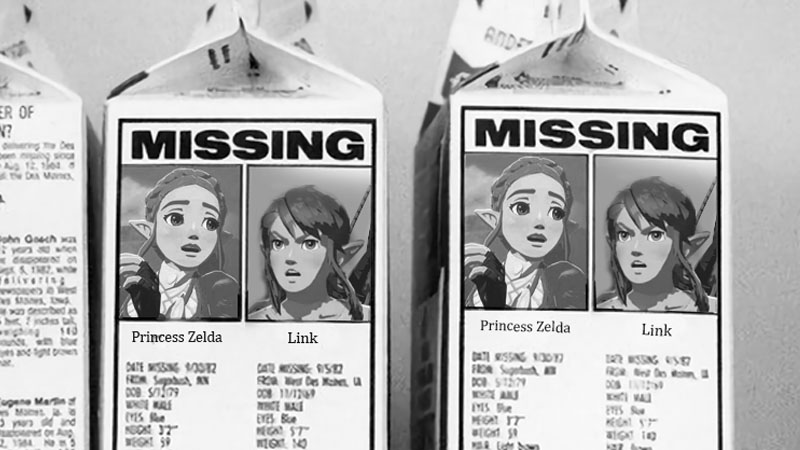
Has the absence of Breath of the Wild 2 got you down? Unsatisfied with the Link’s Awakening remake? Is Age of Calamity too much of a rough slog to enjoy? Fret not; the Zelda formula has been extensively imitated across platforms over the years.
Just what is it that makes a Zelda game? Many would say that it is the vast setting and spirit of adventure; combing intricate dungeons and taking it easy in a relaxing village. Finding key-items and finding solutions to environmental puzzles to progress are definitive staples to the formula. Typically, the protagonist’s abilities expand during the course of the adventure; symbolically representing inner growth.
While Skyward Sword will be getting an HD remaster, that would mean having to play one of the more divisive entries for that sweet Zelda fix. While it is possible Skyward Sword could be getting many tweaks to make it more enjoyable, why not check out some alternatives that scratch that Zelda itch?
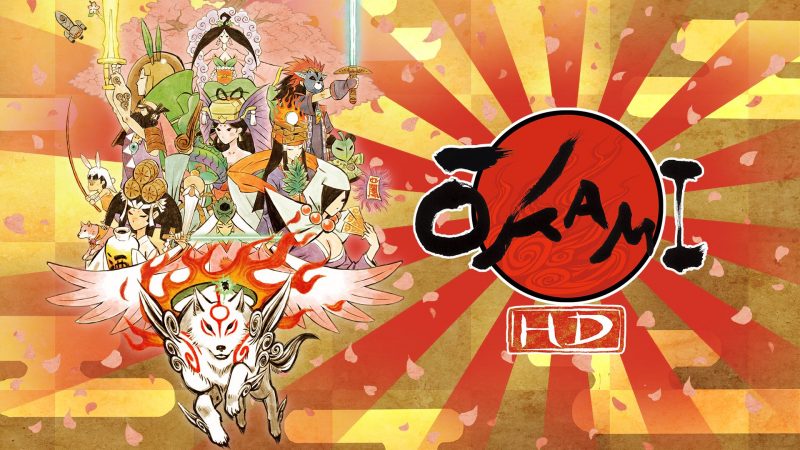
Okami HD
Developer: Clover Studios
Publisher: Capcom
Platforms: Microsoft Windows, PlayStation 4, Xbox One, Nintendo Switch, PlayStation 3, Wii
Release Date: September 19, 2006
Players: 1
Price: $19.99 USD
Before Bayonetta, Hideki Kamiya and his boys at PlatinumGames were Clover Studios; a subsidiary branch from Capcom that housed their best talent. Okami was the other “wolf” Zelda game from 2006, released only a few months before Twilight Princess. Outside of a playable wolf premise and a slow start, both games offered very different experiences.
Amaterasu is a sun goddess, manifested in the form of a stark white wolf. Her adventures to cleanse the world of darkness is accompanied by a traveling artist who does most of the expository dialogue, and he also happens to be a flea or maybe a tick. Okami‘s cast is surprisingly large and very fleshed out.
Anyone who believes that Kamiya only makes brainless action games needs to check themselves, because Okami proves otherwise. There is a great deal of care put into the scenario’s writing. Many plot points get subtle build up, and get masterful pay-offs later. Meaningful character arcs is one characteristic that makes Okami eclipse most efforts from actual Zelda games.
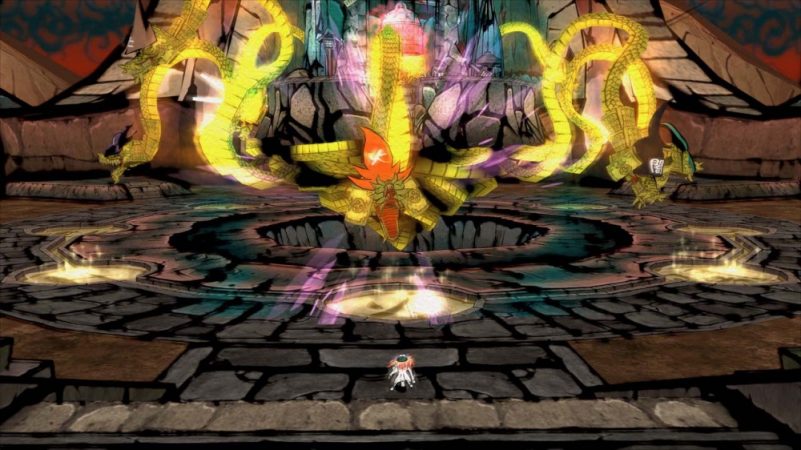
The first thing most people will notice about Okami is its distinctive calligraphic art style. Inky black brush strokes emphasize edges, and create strong outlines on every character. It forms identifiable silhouettes for every character in the game, and is also highlighted through animation and movement.
Amaterasu’s control feels very tight and responsive. She moves incredibly fast, and her combos are as vicious as her feral canine form would suggest. Compounded with the expressive inky brush strokes, there is a strong sense of her carnal and rough attacks. The feedback from this is unlike anything from other action games, and the way ink splatters is a clever way to have blood in a game that has no blood at all.
The ink of Okami is crucial element to every aspect of the game. Unlike Link, Amaterasu won’t be able to carry all kinds of tools or accouterments to negotiate with environmental puzzles or bosses. Instead, she has the celestial brush where she is able to draw up gestures to create objects from ink. The player will be able to draw basic shapes with the right stick to execute functions, and it is no more complex than pulling off a fighting game style input.
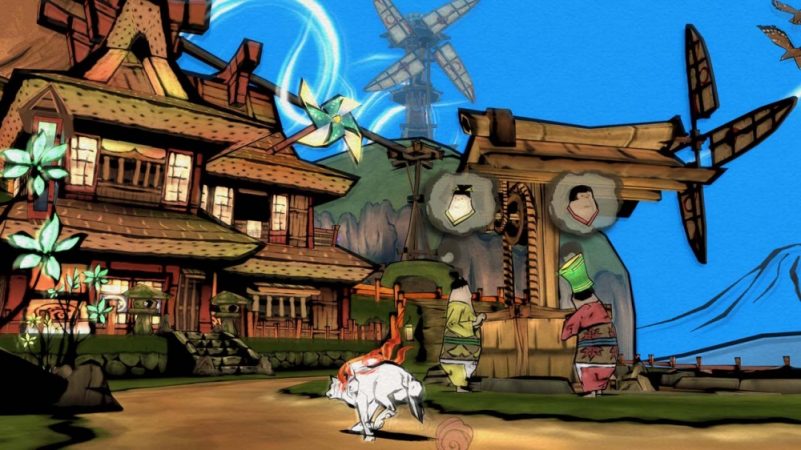
Amaterasu gains a lot of abilities that are not too different than what Link has acquired over the years. She can change the time of day, hook-shot onto certain surfaces, go fishing, and bomb walls. Since she has access to her abilities at all times without a menu, Okami has a higher skill ceiling than most Zelda games. It is possible to pull off some incredible combos on enemies with the celestial brush and use Amaterasu’s abilities in creative ways.
Combat does have a drawback of having all encounters happen in a closed off arena, and this was likely done as a resource management compromise. It is almost like a random encounter in an RPG. The upside to this is that each encounter is tightly controlled by the designer, so there is never any camera issues when battling.
Okami is one of the most impressive works of art to ever come out of Capcom. Thankfully it has been made widely available across many platforms; and they all generally play excellently, with the later editions having reduced load times. Every version is modestly priced and easy to come by. Naturally, the PlayStation 4 and Xbox One versions will have the sharpest image quality, with the Switch HD version being portable.
Images: Nintendo
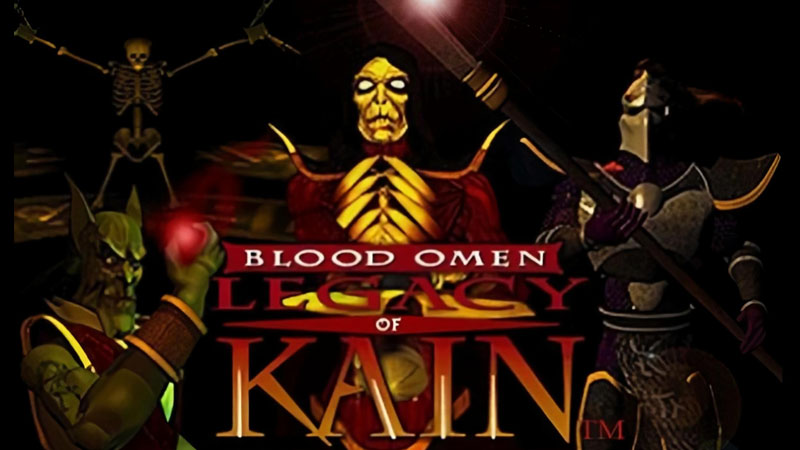
Legacy of Kain: Blood Omen
Developer: Silicon Knights
Publisher: Crystal Dynamics
Platforms: Microsoft Windows, PlayStation, PSP/PS VITA/PlayStation 3 (via PSOne Classic digital download)
Release Date: November 1, 1996
Players: 1
Price: $5.99 USD (via PSN)
Before Crystal Dynamics was a slave to Square Enix, they used to produce some of the most memorable games on PlayStation. Silicon Knights’ Legacy of Kain: Blood Omen was a standout title that Crystal Dynamics published, and still is one of the darker and more mature examples of a Zelda-like ever produced. This was only a few years after the kid-friendly A Link to the Past, so interest was still high for a game that offered a similar experience.
Blood Omen is a very violent, overhead 2D Zelda-like. Kain was a traveling noble who gets savagely killed by a group of brigands, and is reborn as a vampire for a chance at some delicious and nutritious revenge. What transpires is an elaborate plot set in motion from forces beyond the understanding of mortals, and becomes an immersive dark fantasy adventure where the player assumes the role of a monster.
As a vampire, Kain is weak during the day and requires to feed on blood, otherwise he succumbs to a true death. Being a vampire isn’t always glamoring nobles at parties and biting them on the neck.
Kain realizes being a vampire actually sucks, and sucking is something he will learn to do in order to survive. His life-force is gradually draining, and being mindful of how he dispatches foes will become an important aspect of the gameplay.
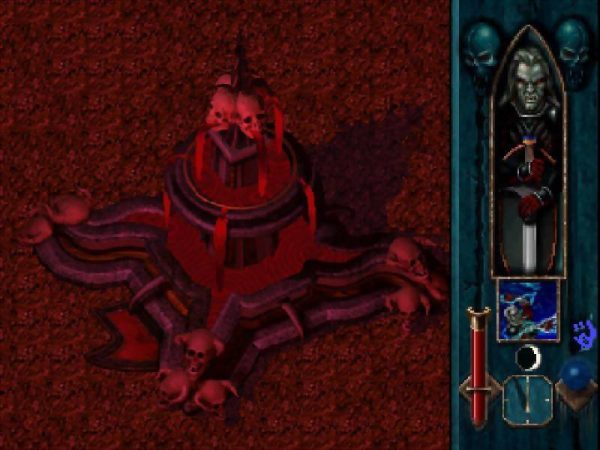
While it may be appealing to immolate thugs with a flaming sword, or to strip the flesh from their bones with a flay, doing so robs Kain of a hard earned meal. In fact, most of Kain’s acquired abilities and curious accouterments are brutal and savage weapons that make things tricky for him to get a decent snack.
Unlike Link, Kain is effectively a bad guy, and the people of Nosgoth will never let him hear the end of it. Being a terrible creature of the night means most NPCs will be hostile towards him, and the only way to have any peace while taking it easy in a town is to don a magical disguise that assumes the form of a peasant.
This leads to interesting situations where the player can make Kain operate like a serial killer or a spider who traps isolated victims and drains them of all their blood. Blood Omen offers a lot of freedom and flexibility as far as player’s choice is concerned and the way it constantly tempts Kain with an easy kill is palpable.
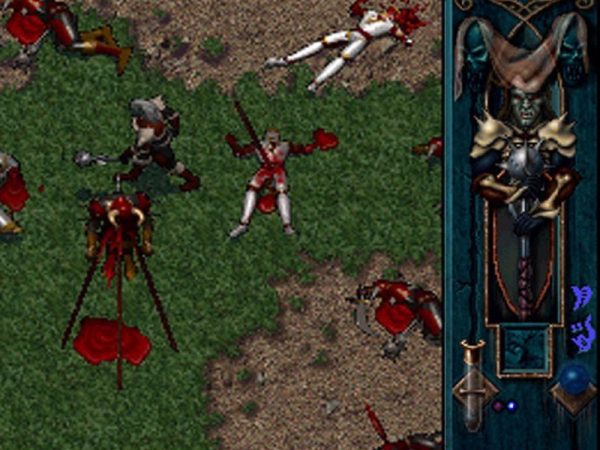
The kinds of abilities that Kain earns through his quest will have him transform into werewolves and mist like any self respecting vampire. These abilities will help access new areas in a manner befitting a quality Zelda-like. There is even a mechanic to revive himself thanks to the consumable “heart of darkness,” which is a clever synergy to how an immortal would resurrect himself in the context of a video game.
One of the most standout aspects of Blood Omen is its stellar voice acting. Simon Templeman as the voice of Kain is a truly inspired casting choice, and truly embodies the character. The man is savors every line, and carries each delivery with incredible snooty confidence. Even his distinct battle cries when swinging a sword sounds awesome.
Sadly, Blood Omen is a bit on the rough side. The game is rife with lengthy load times that transition between every screen, including the inventory. The frame rate is also unbelievably laggy at times, and makes the action slow down to a crawl. Thankfully, this game can be acquired very cheaply on PSN, and is playable on any portable Sony console or PlayStation 3 for about six dollars.
Images: GameFAQs
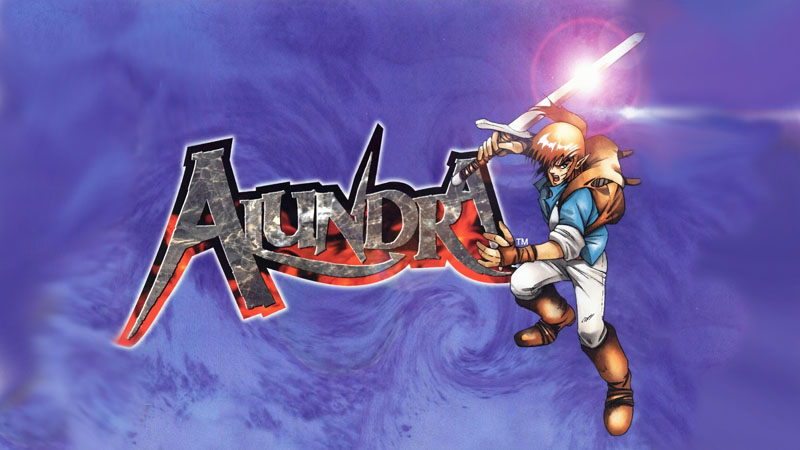
Alundra
Developer: Matrix Software
Publisher: Working Designs
Platforms: PlayStation, PSP/PS VITA/PlayStation 3 (via PSOne Classic digital download)
Release Date: January 8, 1998
Players: 1
Price: $5.99 USD (via PSN)
Landstalker was a SEGA Genesis Zelda-like that held its own against Nintendo’s juggernaut. The minds behind it felt they could do better, and when they reassembled at Matrix Software, they would create one of the greatest overhead 2D action-adventure games ever made.
The story begins humbly enough with the protagonist getting washed ashore from a shipwreck. After getting his bearings within the local village, it’s discovered that the villagers are getting Freddy Krueger’d in their nightmares. The protagonist happens to be endowed with a powerful gift; he is a “dreamwalker,” able to enter people’s dreams and save them from their terrible fates.
A powerfully emotional and beautifully written dark epic ensues. Human nature and the meaning of what is real and what is not are the existential core of Alundra‘s themes. At the time of release, this game was tragically overlooked due to it being 2D, and not embracing the 3D polygonal craze that everyone was getting swept up in. It can be appreciated now, thanks to PSN.
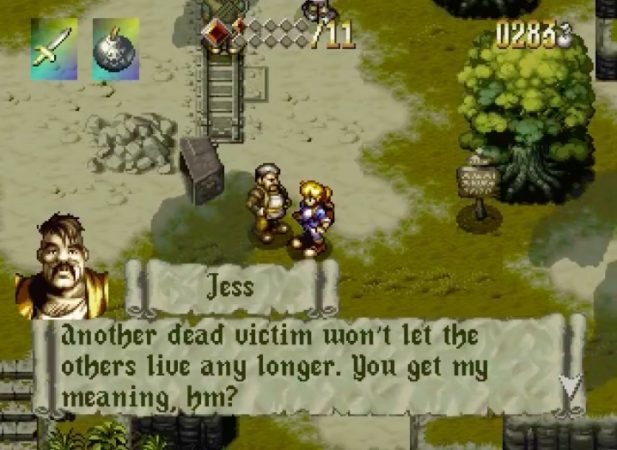
The pixel art and animation in Alundra is some of the best seen in a 2D Zelda-like. Colors are rich and easy on the eyes; earthy in most cases, and always very natural. Yoshitaki Tamaki’s character designs are utterly flawless, and perfectly capture the spirit of adventure. Each character looks distinct and is highly expressive.
The gameplay features fairly straightforward overhead combat with some platforming. Terrain has multiple layers of elevation, making the world have a profound sense of depth that makes it have more dimension than any other 2D overhead Zelda-like.
What truly sets Alundra apart from other titles in this subgenre, is its emphasis on puzzles. The level design is often intricate, and will synergize with many environmental puzzles. These can often get very tricky; much more challenging than anything in any 2D Zelda game by a wide margin.
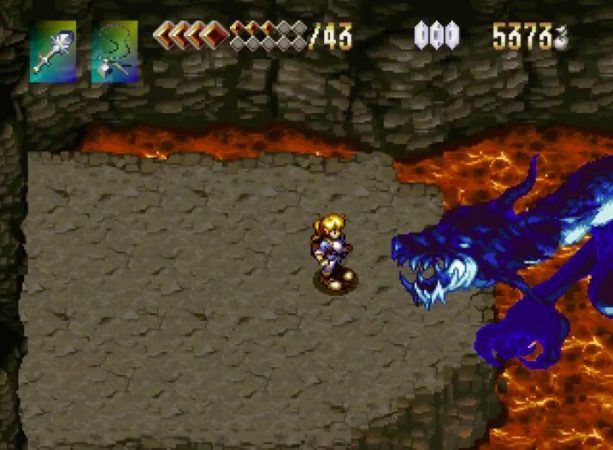
Some puzzle are truly diabolical and are skill-based, requiring quick reflexes. If the puzzles don’t kill you, the nightmares will. Alundra‘s bosses are pretty tough, and can veer off into insane David Cronenberg-esque abominations.
Alundra encourages exploration, and rarely holds the hands of the player. It respects the player enough to figure things out on their own, and sets them loose early on to uncover the mysteries. This is also a really long and challenging game- much longer than any of the other titles in this feature- and might be the longest 2D overhead Zelda-like.
As far as 2D overhead Zelda-likes go, Alundra will put any gamer to task. By the end of it, not only will you be pushed to your physical and mental limits, but you will be an emotional wreck from the high stakes drama. This is a masterpiece and anyone who thinks they have the fortitude ought to give Alundra a shot.
Images: YouTube
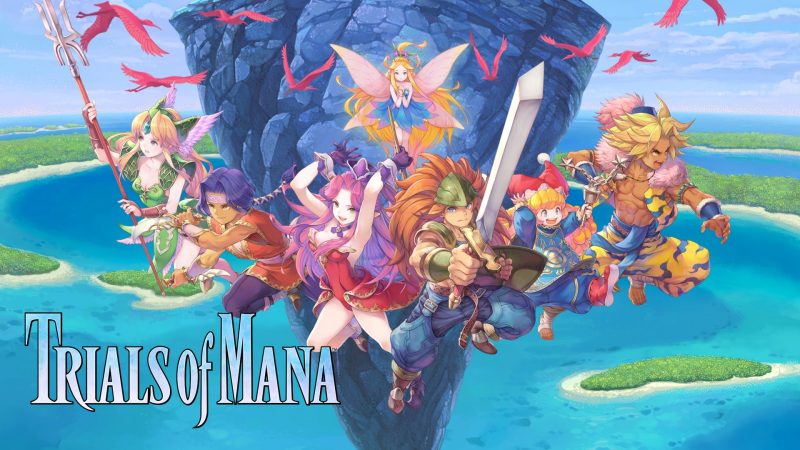
Trials of Mana and Trials of Mana (2020)
Developer: Square / Xeen
Publisher: Square Enix
Platforms: Microsoft Windows, PlayStation 4, Nintendo Switch, Super Famicom (as Seiken Densetsu 3)
Release Date: September 30, 1995, April 24, 2020
Players: 1-2, 1-3 (Secret of Mana)
Price: $49.99 ($39.99 for Collection of Mana)
Trials of Mana‘s remake is an unprecedented situation that generally delivered on all fronts. The remake was very faithful, and made no cuts to any of the contents of the original; but Square Enix also took the time to localize the original game as well as include the first two games.
While the Trials of Mana remake does appear to be on the low budget side, it still manages to impress, and fulfill the need for adventure. The original game was one of the most ambitious Super Famicom action-RPGs around, with six playable characters and different story combinations.
It may look like a mid-level Unreal Engine 4 remake, but team behind this made sure everything was accounted for. Vast towns to explore with full scale houses to enter, big boss battles, z-targeting combat, and even dungeons that can be completed out of order. To top it all off; a deep job-class system and multiple stories to experience make it stand apart from other Zelda-likes.
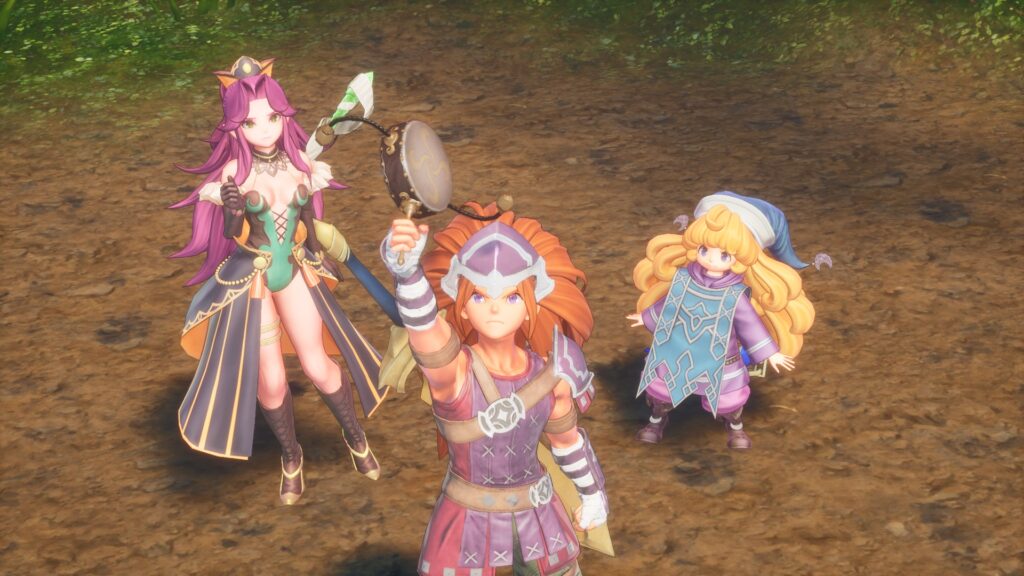
Due to its faithfulness, Trials of Mana still feels like a game made in the mid 90s. Every aspect of its high fantasy is handled straight, and the narrative is unafraid to throw a few big bosses at the player out of nowhere. The grand and ambitious scope is maintained, and the art direction is accurately realized in Unreal 4.
The only noticeable areas where the developers cut corners is the uncanny feeling that the game’s world was assembled in some kind of modular construction with premade assets. The cutscene production values are inconsistent too; there are many instances of clipping and awkward scene direction that is done for the sake of efficiency.
Anybody who can look past the shortcomings will find that Trials of Mana is a lighthearted adventure with a lot of action and colorful cast of characters. It is a bright and lush world that feels inviting, and the upbeat music will keep you humming along as the gang explores the beautiful landscapes. It is easy to get wrapped up in the setting.
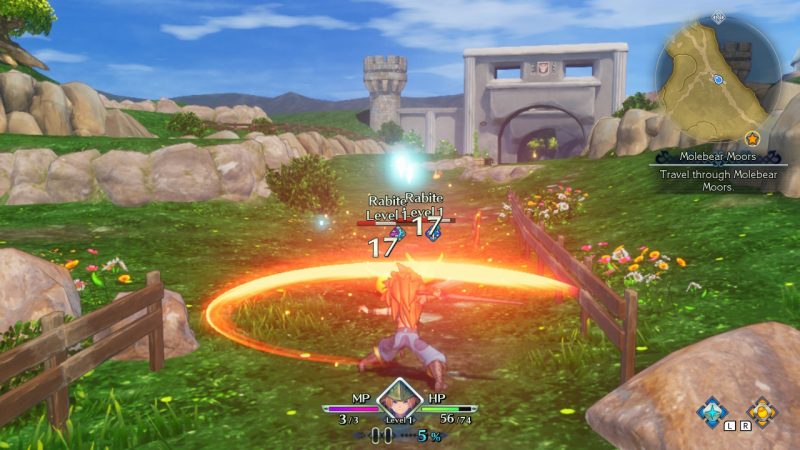
The combat is the other reason to keep playing. The cast is varied, and each character has their own quirks. On top of their bespoke talents is a job class system that grants a decent amount of flexibility to gamers to customize their playstyle when getting into combat.
While is not exactly as deep as Devil May Cry, the battling in Trials of Mana is a step above the basic circle-strafing around a targeted enemy in Ocarina of Time. Characters get a wide range of abilities and attacks. Compounded with the resources that will have to be managed, the fighting has more going on in it than most Zelda games.
Boss battles never rely on the player having to lean on the recently found tool to expose a weakness. All you have is your wits and what you can carry. The only draw back is that Trials of Mana is very light on puzzles, since it has focused more on story, exploration, and combat. It is much more straight-forward than any Zelda game, and there is much less to do.
In case you missed it, you can find our Trials of Mana (2020) review here (we recommend it!)
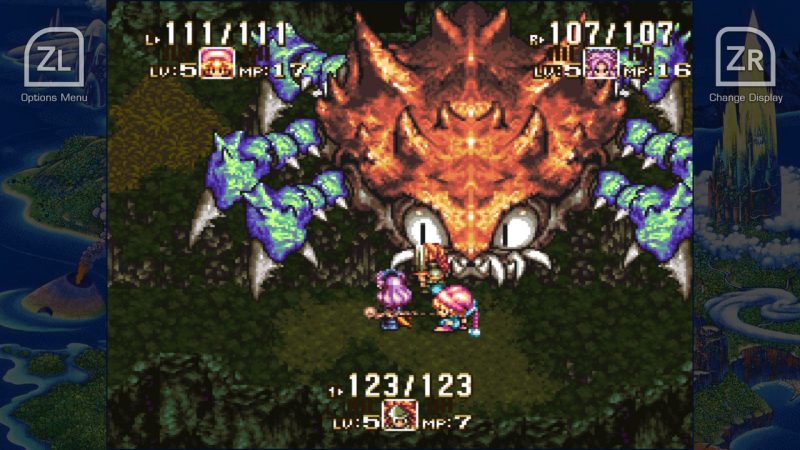
One of the best aspects of Trials of Mana, is that the original 2D game has been preserved in Collection of Mana. The overhead action is still highly stimulating, and this version supports local co-op for those who wish they could go on an epic swashbuckling adventure with a friend.
The pixel art is an utter marvel to behold, and pushed the Super Famicom to its limit. This looked a generation ahead back in the day, and even now it still is a high watermark for art direction. Classic Trials of Mana does for overhead action adventure what Symphony of the Night did for 2D action platforming. The only other title that can meet it is Alundra.
As if the original Trials of Mana wasn’t enough, included on the Collection of Mana is Secret of Mana. This compilation is a must-own for anyone who enjoys overhead Zelda-likes. On the SNES, these were the only other titles that could meet A Link to the Past‘s high bar.
Images: Nintendo
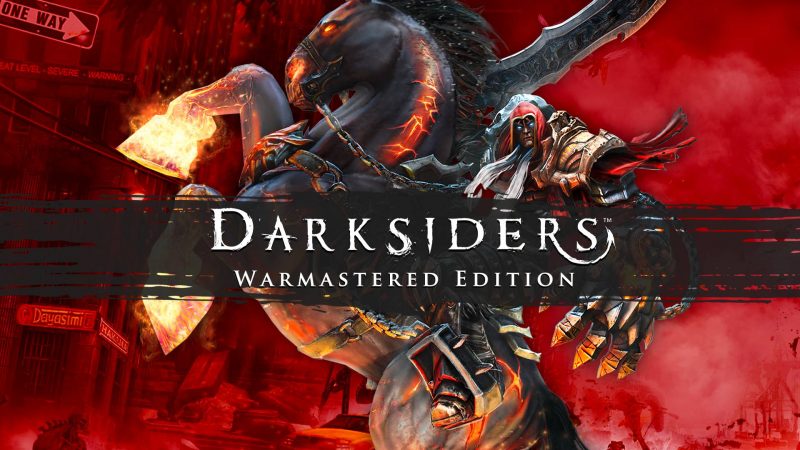
Darksiders: Warmastered Edition
Developer: Vigil Games / Kaiko
Publisher: THQ Nordic Games Publishing
Platforms: Microsoft Windows, PlayStation 4, Xbox One, Nintendo Switch, Wii U, PlayStation 3, Xbox 360
Release Date: January 5, 2010 / November 22, 2016 (as Warmastered Edition)
Players: 1
Price: $19.99 USD / $29.99 USD (eShop)
Darksiders is the most obvious and derivative of The Legend of Zelda-inspired game in this feature. The broad pitch of this was to make something like Ocarina of Time, but with a gritty and post-apocalyptic flair as envisioned by Joe Madureira. With a few Devil May Cry and Soul Reaver elements thrown in, you get Darksiders.
This could have easily been an embarrassing disaster. The blatant and bold ripping-off could have made Darksiders feel like an dull and soulless cure for insomnia. Originality shines through thanks to the developer’s spirit of innovation and Madureira’s style.
Madureira’s designs have been cribbed by many over the decades. The man has a distinct art style that has elements of manga and video game influences. His transition from comic book artist to game designer was complete with Darksiders, and it makes a big statement.
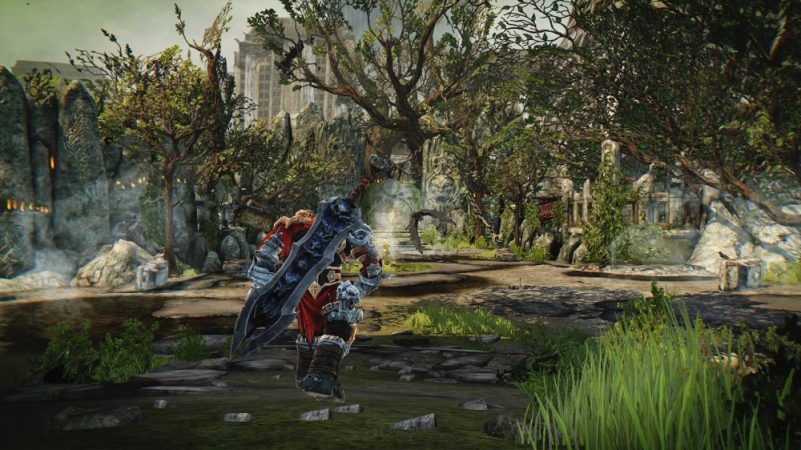
Every character, no matter how minor, is teeming with details and boisterous features that are brimming with raw power. It feels like nothing is ever being held back, and the scale is always trying to impress. Some characters are gigantic and fill the screen; their gestures causing towers to crumble and rifts to form.
In Ocarina of Time, Navi was a very simple graphical effect that acted as Link’s guide and targeting cursor. In Darksiders, The Watcher functions the same as Navi, but is a highly detailed wraith voiced by Mark Hamill. This kind of one-upmanship is constant through out the game, and while it sometimes can be annoying, it is admirable that the developer cared so much.
War’s boomerang couldn’t just be a boomerang, it is an enormous shuriken that can target multiple objects and deliver explosives to its destination. Swordplay is equally over the top and aggressively violent, with elaborate spark effects and flames erupting with every strike. Dungeons are huge and cavernous structures that can take hours to complete.
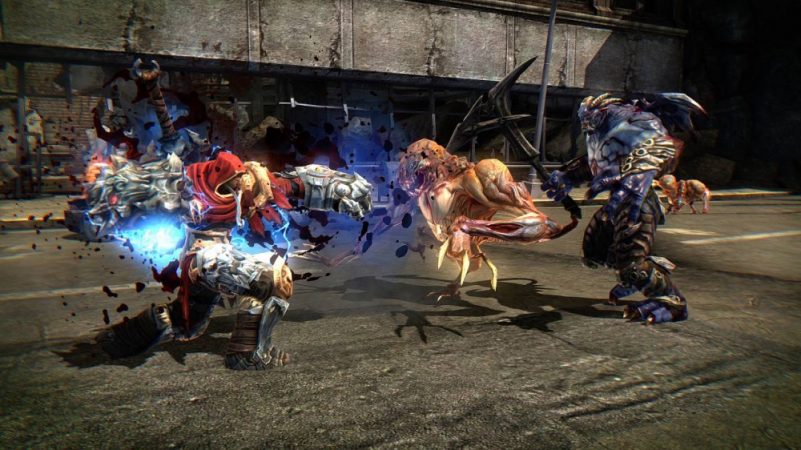
It may be overdesigned and a bit shallow, but it is hard to not be impressed by the effort put into the production values. The world never feels authentic; often seeming like a world built for the player, as opposed as a world that the player exists in. It may be artificial, but it does look good.
Anyone interested in taking on this quest will have a lot of options, since Darksiders has been ported many times over and has gotten better with every re-release. Darksiders: Warmastered Edition is a very good port, and runs very cheap across all platforms; typically under $25 USD.
While the future games would change focus and experiment with different gameplay styles, the original Darksiders has always been a very competent and reliable Zelda-like that has aged well. It does take itself way too seriously for its own good, but it is hard to ignore the calls of your inner teenager who would think this is the coolest game ever.
Images: Nintendo
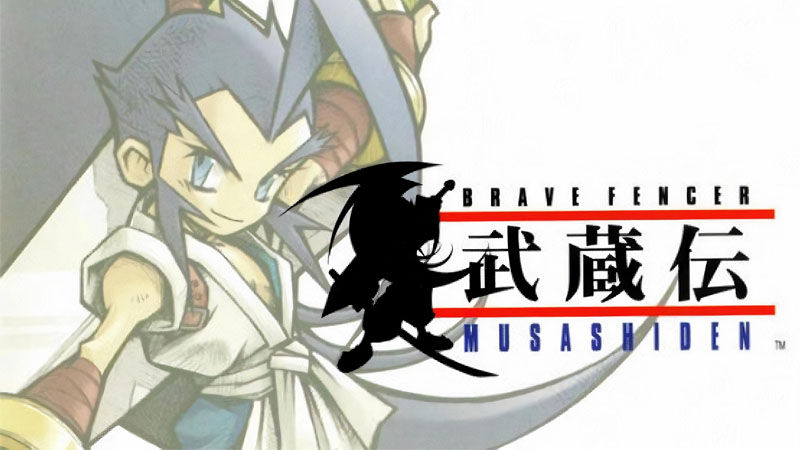
Brave Fencer Musashi
Developer: SquareSoft
Publisher: Square EA
Platforms: PlayStation
Release Date: October 31, 1998
Players: 1
Price: variable
While the boys at Nintendo were toiling away at making Ocarina of Time, the boys at SquareSoft were hard at work making their own 3D action adventure game. Sadly, only Ocarina of Time would be the one that was destined for greatness, and SquareSoft’s Brave Fencer Musashi would only live on as an obscure cult classic of the 32-bit era.
It is unclear why gamers did not connect to Brave Fencer Musashi. It is possible that it never found its audience, or perhaps it was due to its cartoony art style and emphasis on humor. Sadly, Musashi may never find its audience; damned to eternal obscurity because it was never re-released on PSN, and copies are rare and usually cost-prohibitive.
Brave Fencer Musashi may be unobtainable for most people, but will they be missing out? For a while, this was considered one of the definitive alternatives for Zelda if you owned a PlayStation. For a game that was made around the same time as its competitor, it is impressive how similar they are in an age when 3D games were only just becoming the standard.
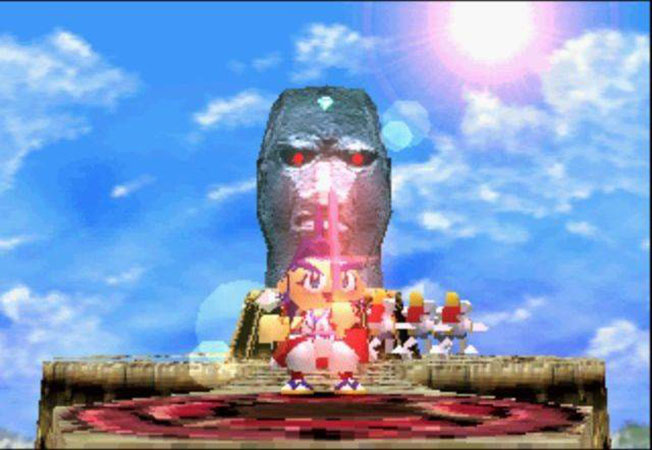
The story begins with a besieged kingdom summoning the legendary hero, Musashi. The only problem is that they summoned him from his childhood, before he grew into the renowned sword master. Never before had the destiny of an entire nation rested on the shoulders of someone so short.
Brave Fencer Musashi is a Zelda-like with a sense of humor. During the localization process, it is clear that the translators had a bit of fun when it came to the voice directing. Some characters are given really over the top accents and ham up their performances, which does elevate the experience due to the simplicity of the character models.
Every character is quirky, and the atmosphere has a Saturday morning cartoon energy to it. There are amusing set-pieces that feature cartoon style antics like running away from a gigantic, rolling stone head. Another sequence may have the pint-sized samurai throwing a large mecha through castle walls. This was pre-Wind Waker, and SquareSoft was already putting a fun spin on the sub-genre.
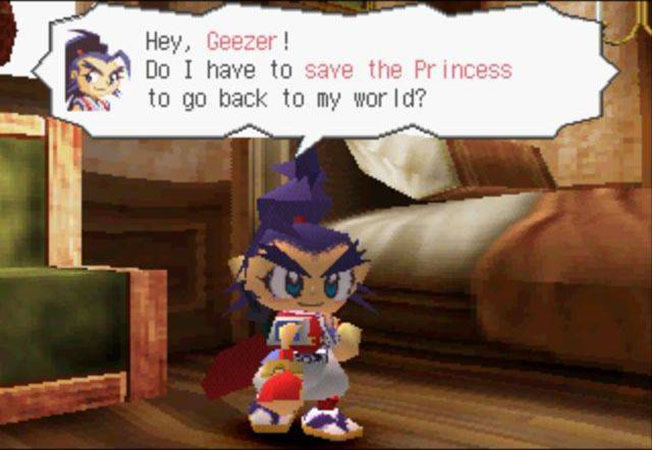
Like any good Zelda-like, Musashi will find himself having to collect several plot coupons in a open ended interconnected world. The kingdom of Allucaneet has day and night cycle which is key to managing Musashi’s sleep schedule. He is a growing boy after all, and he gets tired at night; therefore his fatigue must be managed.
The day and night cycle also affects the townsfolk and monsters in the field. This matters for accessing certain minigames, and also using the Lumina weapon to absorb enemy abilities to get around certain obstacles. Having adventures and collecting action-figures, but making it home in time for bed makes Brave Fencer Musashi feel very cozy most of the time.
Combat is stimulating for an early 3D action-adventure. The overhead perspective helps keep all the assets manageable; preventing the PlayStation to get overwhelmed. It is very polished system that SquareSoft managed to achieve, and it is a shame that not many people can play it. Hopefully, Brave Fencer Musashi will get a faithful remake and will have its time in the sun.
Images: GameFAQs
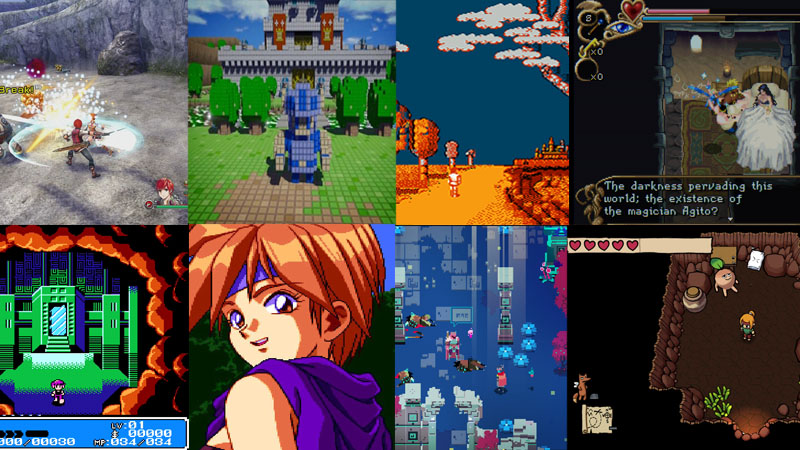
There are so many other options out there for those who want what The Legend of Zelda offers. The Ys series is a tremendous hole that currently spans nine games, with many of them having remakes. The NES had Crystalis which has impressive visuals for an 8-bit game, and Faxanadu is one of the few Zelda-likes that took cues from Zelda II: The Adventure of Link.
The recent Immortals: Fenyx Rising did an admirable job at emulating the gameplay style of Breath of the Wild, and took some steps to improve certain aspects of the formula. The indie scene is also teeming with games that take from Zelda‘s playbook; like Hyper Light Drifter, or the Ittle Dew games.
Obscure classics like Legend of Oasis on the Saturn or 3D Dot Game Heroes on PlayStation 3 are also worth a look, but going into greater detail of all of these far exceed the scope of this feature. There is plenty to choose from if you can’t get enough what Zelda offers. Sound off in the comments below if there are any Zelda-likes that you could recommend!